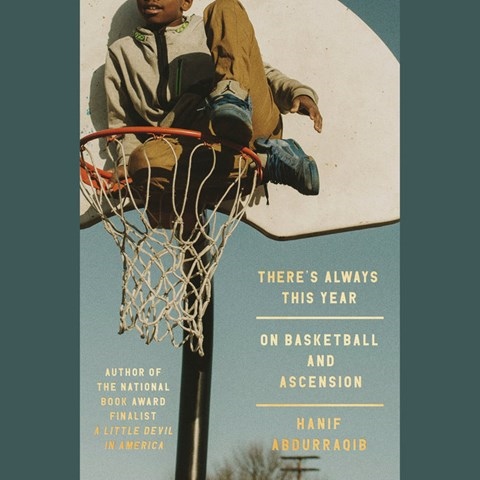One of my favorite genres of nonfiction is what I like to call “start here, end there” nonfiction. Put another way: “13 Ways of Looking at [X]” nonfiction. I love it when an author takes a seemingly boring or ordinary subject and transforms it into something lively, vital, surprising, and challenging. These sorts of books never fail to delight me—they always teach me something new about myself or the world. I also think these sprawling, look-at-this-one-thing-from-a-thousand-angles books are often great on audio. A good narrator picks up on the book’s flow and adds to its momentum. This month I’m highlighting three of my recent favorite nonfiction listens that fall into this elusive genre—and the standout performances that bring them to life.
 In THE AGE OF DEER, author and narrator Erika Howsare delves into the weird and messy particulars of humanity’s relationship with deer. Her narration, while never dry, is even and unobtrusive. Instead of trying to create voices for the many people she interviews, she narrates the whole book in the same quiet, curious, measured tone. This assured performance makes space for the content of the book to truly shine. Howsare’s observations about deer are nuanced and thought-provoking. She explores everything from hunting and hunting culture to wildlife rehabilitation projects; deer-car collisions and wildlife corridors to the ways deer show up in art, music, and poetry. She talks to artists, scientists, conservationists, gardeners, restaurateurs, government officials, and primitive skills practitioners, all of whom have different relationships with deer. The end result is a book that’s both specific and universal; it’s about deer, but it’s also about our relationship with each other, and with the natural world.
In THE AGE OF DEER, author and narrator Erika Howsare delves into the weird and messy particulars of humanity’s relationship with deer. Her narration, while never dry, is even and unobtrusive. Instead of trying to create voices for the many people she interviews, she narrates the whole book in the same quiet, curious, measured tone. This assured performance makes space for the content of the book to truly shine. Howsare’s observations about deer are nuanced and thought-provoking. She explores everything from hunting and hunting culture to wildlife rehabilitation projects; deer-car collisions and wildlife corridors to the ways deer show up in art, music, and poetry. She talks to artists, scientists, conservationists, gardeners, restaurateurs, government officials, and primitive skills practitioners, all of whom have different relationships with deer. The end result is a book that’s both specific and universal; it’s about deer, but it’s also about our relationship with each other, and with the natural world.
 In SMALL FIRES, Rebecca May Johnson blends memoir, history, feminist scholarship, literary criticism, and food writing into a wholly unique exploration of recipes. Kim Bretton’s narration is spirited and fiery—she captures the visceral quality of Johnson’s writing, highlighting the sounds, sights, and smells of the kitchen where the book is centered. Johnson spent over a decade cooking the same recipe for a simple tomato sauce, over and over again. As Johnson sautés garlic and simmers tomatoes, she contemplates the many meanings and uses of recipes: as art, as collective memory, as historical records, as protest. She explores food, cooking, and recipe writing and how they intersect with the physical space of the kitchen, which has long been associated with domesticity and femininity—and not critical thinking or literary production. With passion and wit, Johnson proves just how absurd these false binaries are. Bretton perfectly embodies Johnson's many modes, from sensual and playful to academic and contemplative.
In SMALL FIRES, Rebecca May Johnson blends memoir, history, feminist scholarship, literary criticism, and food writing into a wholly unique exploration of recipes. Kim Bretton’s narration is spirited and fiery—she captures the visceral quality of Johnson’s writing, highlighting the sounds, sights, and smells of the kitchen where the book is centered. Johnson spent over a decade cooking the same recipe for a simple tomato sauce, over and over again. As Johnson sautés garlic and simmers tomatoes, she contemplates the many meanings and uses of recipes: as art, as collective memory, as historical records, as protest. She explores food, cooking, and recipe writing and how they intersect with the physical space of the kitchen, which has long been associated with domesticity and femininity—and not critical thinking or literary production. With passion and wit, Johnson proves just how absurd these false binaries are. Bretton perfectly embodies Johnson's many modes, from sensual and playful to academic and contemplative.
 No one writes this kind of nonfiction better than Hanif Abdurraqib, and he’s at his very best, as both writer and narrator, in his latest book, THERE'S ALWAYS THIS YEAR. It’s ostensibly about basketball, and more specifically the career arc of LeBron James, but of course it’s actually about so much more: home and what it means to belong to a place; mortality and the passage of time; faith; Blackness; failure and flight; Ohio; the work of loving and surviving. The book itself is structured like a basketball game, with four quarters and a clock ticking down. Abdurraqib’s prose is almost unbearably beautiful at times; It feels like an extended prose poem. What’s most extraordinary about his narration is the way he translates all of this momentum and movement to audio. His voice is raw, emotional, and full of love. It rises and falls in breathless crescendos, getting louder and louder before gently quieting down again. Somehow, Abdurraqib maintains this intensity throughout the whole 9-hour book. It’s a profoundly moving and powerful experience.
No one writes this kind of nonfiction better than Hanif Abdurraqib, and he’s at his very best, as both writer and narrator, in his latest book, THERE'S ALWAYS THIS YEAR. It’s ostensibly about basketball, and more specifically the career arc of LeBron James, but of course it’s actually about so much more: home and what it means to belong to a place; mortality and the passage of time; faith; Blackness; failure and flight; Ohio; the work of loving and surviving. The book itself is structured like a basketball game, with four quarters and a clock ticking down. Abdurraqib’s prose is almost unbearably beautiful at times; It feels like an extended prose poem. What’s most extraordinary about his narration is the way he translates all of this momentum and movement to audio. His voice is raw, emotional, and full of love. It rises and falls in breathless crescendos, getting louder and louder before gently quieting down again. Somehow, Abdurraqib maintains this intensity throughout the whole 9-hour book. It’s a profoundly moving and powerful experience.






